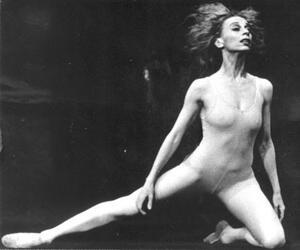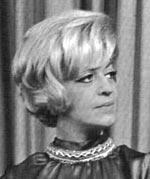Marika Gidali
After surviving the Holocaust and immigrating from Budapest to Brazil, dancer Marika Gidali became an influential performer, teacher, and choreographer at a time when the arts faced serious repression under military dictatorship. Gidali began dancing at Brazil’s Hungarian Club at thirteen and soon joined the cast of the Ballet of the Fourth Centenary. In 1956 she began dancing with the Ballet Company of Theatro Municipal do Rio de Janeiro. Gidali later set up her first school, and in the mid-1960s, the most difficult period of the military dictatorship in Brazil, it was the meeting point for many artists. The dance group she subsequently set up, Afirmação (Affirmation), encountered the problems of dance in Brazil, ranging from financial trouble to questions related to dance technique, choreography, and music.
Family and Early Life
Dancer Marika Gidali was born in Budapest on April 29, 1937. Her father, Bela (Benjamin) Gidali (1909–1990), a tailor by profession, originally came from Tild (Telince), Slovenia, and spoke various languages and dialects fluently. Her mother, Erzsébet (Elizabeth), née Goldstein (1911–1990), was a seamstress from a humble family in Budapest. After they married, the couple made clothes for both men and women in their apartment in Budapest.
In order to cope with the outbreak of antisemitism during World War II and obtain a safe-conduct pass from the Hungarian authorities, Marika and her sister Agnes (b. 1935) were baptized. When she was very young Marika had to face anti-Jewish prejudice. She witnessed Jews forced to wear a yellow star on their arms and experienced the invasion of the family’s apartment by the military, the lack of safety, and the crushing life in the Pest ghetto. During the war the sisters were separated from the parents, fighting for their survival between the Red Cross orphanage, the Pest ghetto, and their own building’s basement. At the end of the war, the parents, who had managed to survive the war, came back to Budapest and recovered them
Soon after the birth of Marika’s younger brother Peter Pal (1946–2003), the Gidali family moved to Brazil, where Elizabeth’s sister was already living. Because it was difficult to obtain a visa and because of the Brazilian government’s antisemitic immigration laws, the family entered via the Uruguayan border and settled in São Paulo after almost four months spent in Italy.
Becoming a Dancer
At thirteen, Marika, who had already shown a gift for gymnastics, began to present short dance routines at the Hungarian Club, where she also took part in plays. In 1953 she joined the cast of the Ballet of the Fourth Centenary, a company founded in 1953 and directed by the Hungarian choreographer Aurell M. Milloss, an important figure in international dance who had worked with well-known groups in Europe. Milloss choreographed sixteen ballets for the company and invited artists such as Candido Portinari (1903–1962), Roberto Burle Marx (1909–1994), Lasar Segall (1891–1957), Emiliano di Cavalcanti (1897–1976), and Clovis Graciano (1907–1988) to design the sets.
In 1956, when the Ballet of the Fourth Centenary was disbanded, Marika accepted the invitation of Tatiana Leskova, director of the Ballet Company of Theatro Municipal do Rio de Janeiro and worked under the direction of Vaslav Veltchek, Igor Schettzof, and Leonide Massine, taking part in ballets created by Yvette Chauviré, Tamara Toumanova, Lupe Serrano, the sisters Maria and Marjorie Tallchief, Istvan Rabovsky, Nora Kovács. At this time she discovered the work of Maurice Béjart and was excited at the new possibilities of movement presented in the ballet Symphony for a Lonely Man, performed by Béjart’s company in Rio de Janeiro.
In 1957 Marika returned to São Paulo, where she joined the recently formed Ballet of the Cultural Artistic Theater organized by Lívio Rangan. When this group folded, she joined the Friends of the Dance group directed by the Argentine dancer Ismael Guiser (1927-2008). When the group dissolved in 1959, Gidali set up her first school and began to choreograph shows for television. Her first son, Edgerd, by her marriage in the early 1960s to the actor Raymundo Victor Duprat (b. 1928), was born in 1964. In 1965 Marika took part in the Cologne International Festival and was invited to dance in the Cologne Opera. She later reflected: “When I went to test my dance in Germany, my mother went with me. In case I wanted to stay, she knew how to bring me back. The fact that her daughter was dancing in Germany was not the dream of a Jewish matriarch who had saved her children, like a lioness, from the hands of the Nazis” (Otero, 156).
Innovative Approach: Between Dance and Theater
In the mid-1960s, the most difficult period of the military dictatorship in Brazil, Gidali’s school was the meeting point for artists from both the theater and dance. The dance group she subsequently set up, Afirmação (Affirmation), encountered the problems of dance in Brazil, ranging from lack of money to questions related to dance technique, choreography, and music. Gidali always wanted to be a classical ballerina, but, as she said, “I suffered because I didn’t have the ideal physique, that is: long legs, a straight back, a long neck, curved feet. I didn’t have any of these. I fought so much, that the technical mysteries were no problem for me. It took years to realize that my kind of dance was different, more human and theatrical” (Otero, 181).
In 1958 Gidali met Renée Gumiel (1913-2006), a French dancer and choreographer living in Brazil who showed her a new kind of dance language. Gidali used it in the ballets Huis clos and The Curra, in which she developed the theatrical side of dance. However it was in her partnership with the theatrical director Ademar Guerra that Gidali succeeded fully in blending a dialogue between theater and dance, choreographing important works such as Marat-Sade, Le Bourgeois Gentilhomme, America Hurrah!, Lulu, Mahogany, Lay Mass, Hair, Missing Brazil, The Henfil Show, and Tom Paine.
In 1970 she divorced Raymundo Duprat and in 1971 married the dancer Décio Otero (Jannuzzi, b. 1933), with whom she produced the television series Invitation to Dance for Culture Television, São Paulo. The episodes showcased various styles of dance, from classic to theatrical, and were narrated by important artists from the Brazilian theatrical scene.
In 1971 the couple also set up the Ballet Stagium, which introduced a repertory based on Brazilian themes and created an aesthetics and an identity that had considerable repercussions both in Brazil and Latin America. Their choreography pointed to the country’s cultural issues, in artistic, social, and pedagogical perspective, reflecting the developments of Brazilian life and society through a universal language. Their current repertoire includes works such as Pantanal, The Amazon Forest, Diadorim (inspired by the classic Brazilian novel Grande sertão: veredas [The Devil To Pay In The Backland] by João Guimarães Rosa), and Kuarup. These works were based on the studies and experiences of members of the group, who took their dances around Brazil as far as the Indian village in the Xingu region. Social questions such as violence, racism, AIDS, oppression, and genocide were incorporated into their works. In 1985, Gidali performed the ballet Crimes, choreographed by her husband and set in a concentration camp. In it, she played the part of a Jewish woman behind a barbed wire fence witnessing in horror the genocide of the Jews. In 2015 the company produced an homage to the musician Ary Barroso, O canto da minha terra [The chant of my country], which operated in the space between dance and textuality.
Marika Gidali’s childhood memories and the rejections suffered by Jewish children, and particularly her understanding of the transformative power of dance both for the dancer and the audience are present in the countless educational projects developed by the Company inside juvenile detention institutions such as the FEBEM (Fundação Estadual para o Bem Estar do Menor, or State Foundation for the Well-Being of Minors), and SOS Criança (SOS Children), as well as on the most improbable stages on which she has danced, including public schools yards, slums, prisons, cinemas, squares, hospitals, churches, subway stations, and samba school parades.
Of the five children from Gidali’s second marriage—Antonio Marcos and Eugenio (b. 1980), Marcelo (b. 1981), Alessandra and Yolanda Rosa (b. 1983)—four are dancers and all are involved in The Ballet Stagium.
Book: Otero, Decio, Marika Gidali. Singular e Plural. São Paulo: Editora Senac, 2001
Museu da Pessoa, “A caranda da bailarina.” https://acervo.museudapessoa.org/pt/conteudo/historia/-48584
Ballet Stagium website. http://www.stagium.com.br/?page_id=11
Interview with Marika Gidali by Mona Dorf. https://www.youtube.com/watch?v=7fjfQ5_8WiI




